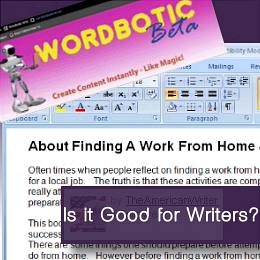Is WordBotic Good for Writers? Claims 5K Words in 20 Minutes.

Did you know: Content generators can be used for a variety of things like boosting your thoughts, brainstorming, research and more?
THEAMERICANWRITER - August 21, 2014 | 14:08 CST
BEAVER DAM, Wisconsin - WordBotic was created by a company called Blue Lotus Productions, Inc. located in Wisconsin. I bought the WordBotic tool because I was able to see how I could personally use it (not necessarily the way it was designed to be used). I don't typically buy tools like this, but I came into the knowledge of its existence the other day. So I decided to try it. The price was at $17 for the Lite version some days ago, which is what I paid for it. I did not buy the larger packages because I felt the Lite version would be sufficient for how I intended to use it. I see the price has gone up since then. I guess the $17 was an introductory price, or maybe it was on sale. I don't know.
Nevertheless, here is what I think of WordBotic after using it. I lay out the foundation (that can be applied to any content generator) before answering the question, 'Is WordBotic good for writers?' If you want to skip to the section where I tell you why the answer is yes, then please do a CTRL+F on this page for the phrase: How WordBotic is Helpful for Writers -- and you should be taken to it. Or you can just scroll down until you locate those words in bold black letters.
WordBotic's Fill-in-the-Blanks Technology
The WordBotic tool is a fill-in-the-blanks technology that is completely web-based. That means no software to download and install on your computer. Web-based tools can be bad to buy because if the servers go down, then you don't have access to what you bought until it's back up again. So I don't usually spend money on web-based products. I prefer standalone products that can work entirely on its own regardless if I'm connected to the Internet or not. That way if the maker's site goes down, I will still be able to use the product since it is standalone (not connected to anything and can function on its own like software). This product, however, is web-based. If I do spend money on a web-based product, then it's going to be on the very low end of the price scale. And it has to make sense to me. In this case, $17 was the lowest end of the price scale and that made sense to me considering it is web-based, and in Beta stages as shown on its product page. I was not going to pay more. I got unlimited lifetime license for $17. I feel I got my money's worth.
The fill-in-the-blanks setup of WordBotic kind of reminds me of a blend of Mad Lib and Dr. Sbaitso. I know I just dated myself on the Dr. Sbaitso. I don't know if anyone remembers that DOS program. Nevertheless, those two things I named are what this tool makes me think of when I used it.
It has three variations: You can get 1,500 words, 5,000 words, or 10,000 words. But I personally just got the 1,500 words, what they call the Lite package. And you can create 1500 words on any topic based on a 57-phrased questionnaire you fill out. Then it generates from what appears to be internal information (like Dr. Sbaitso technology) and outputs a 1500-word document for you on your topic. If you get the 5,000-10,000-word packages, then you'd get a 5,000 or a 10,000-word document about your topic.
The specifics are what you put in the questionnaire, and the rest is filled out by WordBotic's "brain" (internal information). So it does not seem to go out to the Internet to get information. It's limited by whatever the makers of it put in it. Again, like the Dr. Sbaitso technology. This is not surprising because not all tools similar to WordBotic (other content generators) pull information from the Internet. Some do and some do not. WordBotic does not seem to be one that pulls from the Internet. This can be a good and bad thing. But there's good and bad to everything.
Have you ever used a content generator?
The Concept of Dr. Sbaitso & Generators
I will be posting a video of Dr. Sbaitso and you can see that after awhile, what he outputs starts to become repetitive. Because remember, he's limited to only what his maker put in his "brain" to "say". The same concept holds true to any content generator that does not pull information from the Internet. Regardless, what anyone tells you -- these are bots and they will repeat themselves. The makers can do whatever they can to try to keep it saying different things (growing the "brain"), but it will still run out of things to say and start repeating itself. It's inevitable because it is not human.
Try playing around with chatbots and it will help put this into perspective for you regarding bots (generators are bots that output data from its maker) so you understand what you're buying whenever you consider using a content generator of any kind. That way you won't be surprised if you noticed it saying the same thing as your previous generated content. You have to continue to build its "brain" -- otherwise known as knowledge-base (whether vague or specific data, or a combination of both) as to aid in slowing down the process of it sounding repetitive. Unless of course, that is intended. The concept is similar with content generators that do rely solely on its maker to build its "brain" and not ones that go out into the Internet to pull data from all sorts of sites created by humans and bots. That has its disadvantages, too, like anything else.
In the upcoming days, I will create a chatbot to illustrate what I stated. I will show you a baby bot and more evolved bot. Chatbots have been around for ages and I do believe there was A.L.I.C.E. before Dr. Sbaitso. They are A.I. or otherwise known as Artificial Intelligence. You've likely spoken to one on a website's "live chat" feature. Some live chat features are actually chatbots and not real humans. They function in a similar way that automated phone systems do when you call a hotel or a customer service line -- nowadays you are prompted with a bot before you reach a human (if you ever reach a human). Some bots "brains" are meant to be limited and some are grown by its maker. It just depends on its purpose when the maker made it. Unfortunately, Dr Sbaitso's brain was never developed further after all of these years. So he's extremely limited. Still like a baby. You have to continue to teach bots (because generators are bots) for it to grow on things to "say". Similar to humans, but the difference is we can teach ourselves (not needing another human to teach us) the computer cannot. The computer needs a human to teach it. And so do content generators.
A Couple of Movies Illustrating Artificial Intelligence

So to reiterate (intentionally unlike generators) what I was saying, with generators that have internally-based "brains" or knowledge-base (much like Dr Sbaitso) at some point, you will run into the generator outputting virtually (if not the exact) same thing over and over and over again. It will run through the data put in its "brain" regardless if it outputs random or in order, but sooner or later it will run out of things to "say" and start repeating itself.
Again, generators that do not pull from the Internet, rely completely on its maker to have new things to "say" or output. You can get firsthand experience if you create your own chatbot. There are sites that allow you to create chatbots for free and most are user-friendly to help people create one within minutes including pre-built knowledge-base for a starting point. Generators that pull from the Internet, rely on not just its maker, but all the human brains that have posted content (bot-generated or non-bot-generated content) on the Internet to use for building or adding onto its "brain".
I am not saying that WordBotic functions like Dr. Sbaitso. I'm saying that Dr. Sbaitso is built on internal data. His "brain" consists of only the data that its maker put in it. WordBotic's "brain" appears to consist of only the data that its maker put in it, too. So after you've gone through the questionnaire, it combines your fill-in-the-blank answers with its "brain" data and gives you content. You'll see what I mean when you get WordBotic (you can see the video above to get a look at part of the process). This is what happens when you're working with a bot that functions on internal information fed by its maker. Do not get me wrong, this is not necessarily a bad thing. Please, keep reading.
How WordBotic is Helpful for Writers
Just because its "brain" data that fills around your fill-in-the-blank answers is limited to whatever the maker put in, it does not mean it cannot be useful to you as a writer -- and here's why. What WordBotic offers is a starting point. Once you finish the questionnaire (see video above), it generates up to 10,000 words (whichever version you bought) and you can download the content that is delivered on-screen in a Microsoft Word document. And it's formatted, too. From there, you can add or delete content. You can add photos. You can reformat the text. You can do anything in that Word document it gives you with the content. Or you can publish the content without editing anything because it reads well. And it reads well because its "brain" was built by its an English-speaking maker. Blue Lotus Productions is an American company. If it were created by someone who did not speak English well, then you'd end up with a content generator with bad English. WordBotic's "brain" does not consist of bad English from what I've seen so far. And I would expect nothing less than good English from an American-based company. When you're done with that material, then you can go through the process again on a different topic -- at no extra cost.
Get a Boost in Your Thoughts
I would recommend, though, that you modify your Wordbotic-generated content if you are serious about setting yourself apart as a writer. You don't want your writing to look like someone else's writing. The claim to 5,000 words in 20 minutes, I've not been able to prove. For me, it took me about one hour to go through the 57-phrased questionnaire -- but that was because I had no idea what I was going to write about. So this tool gave me a boost in my thoughts. If you already know what you're going to write about, then you'll likely get through the questionnaire faster than I did. So overall, I feel that WordBotic is a great tool to give you a boost in your thoughts (as you cans see illustrated in the video above).
Eliminate Writer's Block
I've read online from a couple of people mentioning it being good for eliminating writer's block. And I agree with that. If you are stuck in your thoughts, the questionnaire alone will help you get unstuck. I don't believe the tool is promoted as a cure to writer's block, but that does not mean it can't be used for it.
Get Help Putting Your Thoughts Into Paragraphs
And if you don't know how to put together paragraphs, the generated content produced by WordBotic at the end of the questionnaire will definitely give you a huge starting point of at least 1,500 words. And it's not just 1,500 words (or more) worth of content, but it is formatted into paragraphs with headings and bullet points -- that you don't even need to do. It's a huge plus for those things I've pointed out. But again, I do recommend you modify it if you are serious about setting yourself apart as a writer.
Suggested Use for WordBotic
I would recommend using this tool as an assistant to boost in your thoughts, word processing, and dealing with writer's block. But it is always going to be up to you to add your personality to the content generated because no content generator can ever do that for you.






